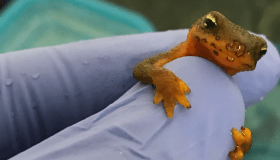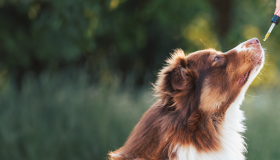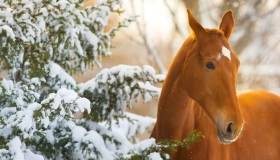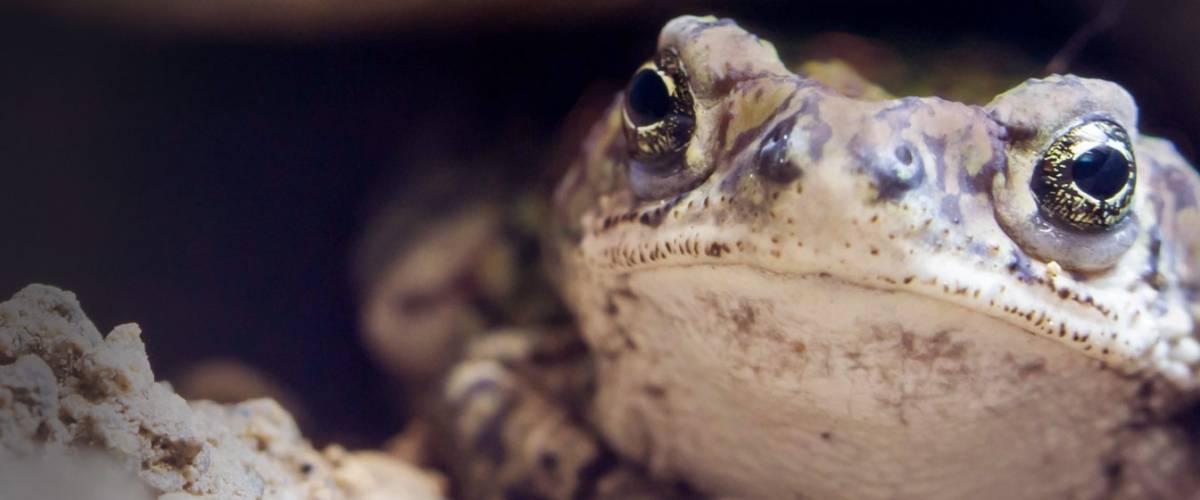
October 14, 2019 – Dr. Kelly Diehl talks with Dr. Valerie McKenzie, Associate Professor in the University of Colorado, Boulder’s Department of Ecology and Evolutionary Biology, and a Morris Animal Foundation-funded researcher. The two discuss the worldwide problem of the chytrid fungal pathogen, Batrachochytrium dendrobatidis (Bd) and Dr. McKenzie’s recent efforts to stop it in boreal toads.
00:17 Dr. Kelly Diehl: Welcome to Fresh Scoop, lucky episode number 13, everything you want to know or don't know about global amphibian decline, and I'm your host, Dr. Kelly Diehl, Morris Animal Foundation's Senior Director of Science and Communication, and today we'll talk to Dr. Valerie McKenzie, a Morris Animal Foundation-funded researcher and a member of the Foundation's wildlife scientific advisory board. And we hope you're learning some things with our episodes. For those of you who may be new, this is the monthly podcast of Morris Animal Foundation, one of the largest non-profit foundations in the world dedicated to funding studies to find solutions to serious health threats to animals.
01:00 DD: Founded in 1948, by Dr. Mark Morris Sr., a veterinarian, we've invested more than $126 million in more than 2,700 studies that have improved and protected the health of companion animals like cats, dogs and horses, as well as wildlife. In each episode, we'll feature one of the researchers we fund or one of our staff members discussing their work in advancing animal health. Whether you're a practicing veterinarian, technician or student or just an animal-loving science geek, Fresh Scoop is the podcast for you. You can learn more about us at morrisanimalfoundation.org.
01:38 DD: So okay, on to today's show. Today, we welcome Dr. Valerie McKenzie. Dr. McKenzie is an Associate Professor in the Department of Ecology and Evolutionary Biology at the University of Colorado, Boulder. Dr. McKenzie received her BS and MS in Biology from the University of Connecticut and her PhD in Biology from the University of California, Santa Barbara. Dr. McKenzie did her post-doc at the University of Colorado, Boulder and has been there ever since. Dr. McKenzie is a Foundation-funded researcher and our go-to person for amphibian research and explanations of all things amphibian.
02:17 DD: So Valerie, thanks so much for joining us today.
02:20 Dr. Valerie McKenzie: Thank you, Kelly, for having me. It's wonderful to be here.
02:23 DD: So before we get into your work, tell us a little bit more about yourself and your background and specifically how did you get interested in biology and ecology and more specifically amphibian?
02:36 DM: Yeah, yeah, it's funny, isn't it, how our winding paths ending up where we are. Yeah, I've always been interested in biology. I've always loved animals since the time I was really young, so when I was an undergraduate at the University of Connecticut, I immediately majored in biology, and I didn't quite know what direction I wanted to go, I just knew that I loved it. I was particularly enamored with marine biology, and it wanted to be Jacques Cousteau, diving and exploring amazing undersea life.
03:10 DM: And so when I was looking around for research to get involved with as an undergraduate, there was a woman, Janine Caira, who was my first mentor, who studied the parasites of sharks and so that was the person doing anything remotely close to marine biology, and so I got so involved in her lab to help out as an undergraduate, and because she studied parasites of sharks, I took her parasitology class and then I got really hooked on parasites. I just found them fascinating.
03:43 DM: So I sort of came into it from a marine biology perspective, and then sharks and parasites, and then parasites derailed me because it was so fascinating that I became interested in studying parasites and I had an opportunity to travel to Guatemala to do a master's degree describing parasites of amphibians and reptiles in Central America, and so that's how I got involved with amphibians and I really loved tropical amphibians and so I've stuck with that ever since, and continued to do a PhD on amphibian parasites, and I still study amphibian parasites and pathogens now. And I work on other animals as well. We have some projects on other types of mammals, including bats and some coyotes, but a lot of our research centers on amphibians.
04:34 DD: Cool. Were you the type of kid, did you have amphibians and reptiles as a kid, were you into that creepy-crawly kind of stuff?
04:43 DM: Yeah, I definitely like those kinds of things. I didn't keep them as pets because I felt early on, and it's funny because I still feel this way, I never prefer having pets that require a cage, and I know some people create wonderful terrarium habitats and are really good at caring for animals in those kinds of environments. But that wasn't quite me, I really liked going out and observing them in nature, but I didn't have that desire to keep them. Which is a certain type of person, there's lots of people who are really good at that, they create wonderful habitats, but that's... Yeah.
05:18 DD: Yeah, that's... My son is always after me for reptiles, which are not actually, even though I'm a veterinarian, I will admit I am not fond of things without legs, so snakes, predominantly, though I can do other reptiles, but I hear what you're saying, it's really fun to kind of observe them in the environment. So I know that a lot of our listeners and we've talked about this, have heard about the declines in our amphibian populations, I think we've heard about it on the news for a long time that this is a problem, and I think there are some misconceptions about what is causing these global declines and I wondered if you could elaborate first in big categories, what are the threats to amphibians worldwide?
06:11 DM: Yes, you're right, it is a huge problem and I agree that I feel like people are becoming more aware of it as a problem, but as we go is I come across lots of audiences and people who didn't know that it was a problem, so I still feel like we have a good ways to go in doing some public outreach to have everybody understand the magnitude of these amphibian declines. But as far as causes there's what I call the usual list of suspects, which is habitat loss, invasive species, climate change, pollution and then, of course, infectious disease. And so a lot of these factors are all affecting amphibians and some of them are interacting together to make problems worse.
07:01 DM: But infectious disease has been a really outstanding cause of amphibian decline. There's a fungal pathogen that's been working its way around the globe causing declines in every continent where there are amphibians. So I'm sure we can talk more about that, but it's... Yeah, it's a big list of factors, but the disease does play a large role in these declines.
07:26 DD: Okay, yeah, I think that's a good point. And we'll talk about the... As you mentioned, the infectious diseases. But I have run into folks, and clearly my husband, for example, I'll use him as an example, who attribute, they know about amphibian declines, but they think more from a climate change perspective, and I think your point is well taken that it may be more multi-factorial. He's always surprised when I say, "Oh, well, there's these other things too." Can you give, even though this is terribly depressing, really an overview of how significant the decline has been in, let's say, the last few decades?
08:11 DM: Yeah, so there have been a couple of points in time where scientists have come together to produce a summary of where are we at with amphibian declines and it's always depressing. There's a group called the Global Amphibian Assessment group, and they've pulled together a lot of information from different amphibian biologists around the world, and their estimates are that about 30% of species are highly endangered and that close to 50% are declining. And then, a recent study that was published just this year in Science magazine, which is of course a really high profile journal, they estimated that about 500 species are currently declining very significantly because of this pathogen, so that's a lot.
09:12 DM: There are about... About 7,000 to 8,000 known species of amphibians on the planet now, which is on par with about the mammals. So if we think about is that a lot or a little, if you think about mammal diversity, which is most people are more familiar with, amphibians are just as diverse in terms of numbers of species as mammals, and to have about half of them declining due to one type of a pathogen is really significant. So it would be, an analogy would be if there was one type of virus that was causing declines in half of the mammal diversity on the planet, so very different things like squirrels and people and whales and coyotes, very different kinds of mammals affected by the same pathogen. That is what's happening in amphibians with this fungal pathogen.
10:03 DD: Right, so good lead-in. I won't pronounce the name of the fungal pathogen. But if you could talk about, what I'll just say is Bd, as that's how we often refer to it, and give everyone... I think some people have heard of it, but if you could give everyone a background on kind of what the pathogen is and especially like, when did this all crop up?
10:27 DM: Yeah, that's a really good question. Right, so this fungal pathogen, the Latin name is Batrachochytrium dendrobatidis which is yes, why we call it Bd for short. So there has been a lot of research on Bd over the last couple of decades, but it was only formally described as an organism in 1999. So when you think about that, everything we've learned about this fungus has really just been in the last 20 years, which is a long time, but in terms of scientific discovery is not a particularly long time, especially for something that seems to have spread all over the globe. Bd, this fungus, infects the skin of amphibians, so it's a little microscopic fungus that gets inside of the skin cells on the amphibian, and it replicates itself and releases more little... It explodes that skin cell and releases more little swimming zoospore stages, and they're tiny and microscopic and they can swim over and infect more skin cells on that same amphibian or they can go into a water source, if the amphibian is in water and spread and infect other amphibians.
11:37 DM: And so their infection numbers can build up. If a particular amphibian species is highly susceptible and they don't have very good immune defenses to the disease, which there are many amphibians where that's the case, then this infection can build up on their skin, and because it's destroying skin cells along the way, it causes them to become really sick, because an amphibian's skin is essential to their functions. An amphibian's skin is a mucosal layer, and it regulates their water and ion concentration and their electrolytes in their body and so it's a very essential organ for amphibians, so when their skin is heavily disrupted, it causes organ failure on a systemic host level. So that's how that pathogen can really affect individual amphibians.
12:24 DM: And like I said, some species are really susceptible to having the full-on disease while other species seem to be tolerant, that their immune system can handle the pathogen and keep it in check. And there's a lot of interesting research on the sort of reasons behind that, as well.
12:41 DD: So Valerie, just because I'm curious, with Bd do we know if this organism has been around a long time? Like I'm thinking about Yersinia pestis, the plague-causing organism. We know that plague's been around a long time. It's been described, I'm sure there's been some genetic drift in the bacteria, but is Bd something that just cropped up like we think of... For example, when canine parvovirus first came about, 40 years ago it was sort of a new mutant variant, and we know a lot about it mutated viruses. I think people get really anxious about all the ones that come from and rightfully so from avian flu. Is Bd old bacteria that just has spread or is it something new?
13:28 DM: That's such a great question. So there's been a lot of research trying to answer that question over the last two decades, really. And so the strongest evidence has been coming out pretty recently, also in the last, I think it was in 2018, another very large paper was published by researchers who study the genomics of the fungal pathogen, and so they were able to isolate and collect strains of the Bd pathogen from different continents and different populations of amphibians around the globe, and they had a huge collection of something like 200 isolates of the fungus. And then they could sequence it and study the whole genome and try to piece it apart to answer that question of where did this thing come from, or how did it arise, or is it novel or has it been there a long time.
14:21 DM: And the story that the genomics points to, is that there have probably been strains of Bd that co-evolved with their amphibians over many thousands or millions of years previously, and that those old strains were not very pathogenic, and they were sort of local fungal things that lived with amphibians over many, many years. And that in recent times because people have been moving animals, including amphibians, around the globe in recent years since the industrial age, people have accidentally moved amphibians around and caused the pathogen, to cause distant strains of the pathogen to come together in more recent years and hybridize and form a virulent strain. So that virulent strain of the pathogen has now been spreading around the globe in more recent decades.
15:23 DM: So that's the story that the genomics is pointing to and they seem to have identified an area in Asia on the Korean peninsula, where there are a lot of different strains and a very high diversity of the Bd pathogen, and that is consistent with the idea that maybe the Bd pathogen has more of its origins in that region of the world and that a hybrid virulent form emerged from the movement of animals by people in the last several decades.
16:00 DD: Okay, so...
16:00 DM: So does that story makes sense?
16:01 DD: Yeah, that does. So before we move to your research, we can talk about another scary disease, and that's Bsal, which I will not again try to pronounce, but can you tell everyone a little bit about that organism?
16:16 DM: Yes, Bsal is the evil twin sister of Bd, or not twin but... Yes. So Bsal is the genus Batrachochytrium, so it's a member of the same genus as Bd, but it's a different species, it's salamandrivorans, so we call it Bsal for short, and this is a pathogen that seems to be affecting salamanders in particular, more heavy. So salamanders are, of course, a group of amphibians. Amphibians comprise the frogs, toads, salamanders and caecilians, these other little legless things that Kelly probably would love.
16:53 DM: So the Bsal pathogen has been emerging and affecting salamanders in Europe. And across different sites in Europe, in the UK they have noticed salamander declines and salamander diseases and in studying this, they've determined that it's a different species, but it's related to the Bd pathogen, and they've also because they caught it quickly, they were able to understand that it was probably brought into Europe via pet trade and animal trade from Asia, that salamander animals were being moved, entered continentally between Asia and Europe, and that that was the route by which this pathogen entered Europe and is affecting those salamanders there.
17:42 DM: And it's this idea that when a new pathogen moves into a new area, the animals in that new area usually haven't seen that pathogen before in their evolutionary history, and so they're what we call immuno-naive to that pathogen, and they don't have the correct immune response to deal with that pathogen because they haven't seen it before, and so that's why they can suffer really heavy mortality because it's a new pathogen to them.
18:10 DM: So the worry now is that that Bsal pathogen could spread from Europe to other parts of the world with salamanders, and the highest salamander diversity in the whole world is actually in the Eastern United States, in the Appalachian Mountains. There are the most species of salamanders in that part of the world than anywhere else, and so there's a lot of concern that Bsal could potentially move via trade by accident into the US and affect salamander diversity in the Appalachians.
18:42 DD: Wow, so I know that's a big, potentially a huge problem. So I wanted to go ahead and turn to your recently funded, congratulations, Morris Animal Foundation grant. And can you summarize what you plan to do and why you're doing this particular study?
19:03 DM: Yes, well, first of all, I am so excited to have a grant awarded from the Morris Animal Foundation. It's just absolutely fantastic, and it's definitely a highlight moment for us as researchers, especially to get funded by Morris, because it's such a wonderful, amazing program, so we are so grateful. So our project is focused on a declining amphibian, and the boreal toad. So the boreal toads live in Colorado, which is where I am based, Colorado, in Boulder, and up at higher elevation, boreal toads, this is where they live, they're a high elevation specialist, so there have been many populations historically across the Rocky Mountains, but their populations have dwindled really drastically, and it's well documented that those declines are because of the same fungal pathogen we've been talking about, the Bd.
20:01 DM: And it's really a difficult problem, because a lot of these high elevation systems, some of them are in national parks, some of them are in Forest Service lands, some of them are in other types of protected lands, and so they're not experiencing the worst effects of habitat loss. These are in relatively remote areas that are not very disturbed in terms of human development, yet they're getting wiped out by this pathogen and it's really a difficult problem, because it's hard to try to help them deal with this pathogen.
20:40 DM: So we've been studying the symbiotic bacteria that live on amphibian skin, so we call this the microbiome, and you probably are familiar with that from... There's a lot of talk about the human microbiome, all the microbes and bacteria that live in our guts and help us do essential functions. There are a lot of bacteria that live in us that are really good for our health and help us and that we probably couldn't live without, so we would call these bacteria mutualists, or beneficial bacteria. And that's true for lots of plants and animals. Many plants and animals also have a microbiome that helps them with their health and providing essential functions.
21:23 DM: So we have been studying the natural microbiome of these boreal toads and we have found that there are certain bacteria that naturally live on them that are really good at repelling and inhibiting the fungal pathogen, and some of these bacteria are able to produce little metabolites, chemicals that they excrete that are like kryptonite for the fungus, so that's a really beneficial bacteria because it's helping protect the host from the pathogen. And so we've been working on designing probiotic treatment, so how can we increase the abundance of that bacteria on the toads during critical life stage times when they're most vulnerable to the pathogen?
22:08 DM: And so our research is about developing this probiotic and how and when can we apply it and all kinds of questions about how can we use this as a tool to actually help toad populations. And it's exciting because it's of course specific to our toad system, but it's also very relevant to lots of amphibians around the world that are declining because of this pathogen, because this kind of probiotic approach could be used for many amphibians. It is important that we use local strains of bacteria. So in our system, we isolate the bacteria from boreal toads in their natural systems and that's important to do for any amphibian where this work might be relevant for, because you don't want to take a microbe from one part of the world and go around and introduce it in totally different parts of the world.
23:00 DM: Because we've learned by now that moving animals and plants and even microbes around into places where they're not native is probably a bad idea. So to be conservative, we recommend that this kind of work be done with local quote native strains of bacteria.
23:14 DD: Right. And actually, let's talk about the probiotic. Because I can't help but when you say that, you think of little frogs having kombucha or something. So how do you... You alluded to it, but if you could describe, like how do you administer probiotics to a population of amphibians that are outside in an environment?
23:39 DM: Yes, exactly, that's been the tough challenge. Well, we've been trying a couple of methods and comparing how effective they are. So we try putting the probiotic in a water solution and have them sit in a little bath of the probiotic solution. And then we also try putting it on their soil and having them crawl around on that inoculated soil. What we're finding, though, is a really important distinction is that it really is important to consider what life stage the amphibian is in when you're going to give them this probiotic. So amphibians, as you're probably well aware, have, they start off as little eggs in the water and they hatch a tadpole stage that is an aquatic swimming tadpole for some number of weeks throughout the summer, and then they undergo a big metamorphosis where they turn from a tadpole into a little toad and then they jump up out of the water as a metamorphosed toad, and then they're more in contact with substrates like soil up out of the water.
24:49 DM: And so we've been trying to understand whether it works to have them treated as juvenile tadpoles or whether it works to treat them after they've undergone metamorphosis, and that's been really, really actually fruitful work, because we've discovered that if you can treat them just before they undergo metamorphosis, it's the most effective.
25:12 DD: Oh, cool, and actually that brings me to another question. Are the amphibians more susceptible to these... To Bd at different stages of their lives?
25:26 DM: Yes, they are, and not all species have been studied in depth with regard to this, but generally speaking, most amphibians can become infected as larval tadpoles, but as larval tadpoles, the infection tends to stay around their mouth parts, which have keratin in their mouth parts, and it's not until after metamorphosis that their skin also becomes keratinized, and it seems that the pathogen requires those keratinized body parts in order to spread around. And so right during and after metamorphosis is a pretty critical time when they're very vulnerable to infection and getting high infection loads and suffering mortality. That's true for lots of species. It's hard to say that's true for every species, but that's also why we are targeting that part of their life stage as when is a good time to put a probiotic, because if they can have the highest defense levels during the time they're most vulnerable, that's a win.
26:30 DM: The other advantage to treating them when they're really close to that metamorphosis life stage is that there are many of them. So when a toad is breeding, it lays thousands of eggs at a time, and then there's thousands of tadpoles in a big batch, and they all tend to sit and congregate in the shallow edges of the pond where the water's a little warmer. And so it happens to be a really good time where you can treat them because they're congregated in shallow warm water, and so you can treat many individuals at once.
27:02 DD: Cool, and I think you alluded to this, some of the challenges you face, but some of the... What are some of the other challenges when you're conducting research, like you do outside with amphibians? And do you have any humorous stories you can share with us about some of these challenges?
27:24 DM: Yeah, no, exactly, it's really fun. All of our lab members, we really enjoy that we get to do this work because we get to go up to these just stunning high elevation mountain streams and pond sites, so they're just beautiful areas up in the back country. But it is tough, working at high elevation, because a lot of these sites are a little bit more remote, and there's usually not cell phone service, so you really have to bring everything you need and you're going to be out there for the day. And at times we've camped near the field sites and other times we stay in a nearby town and take day trips up to the field, we do a combination of those things, but one of my students in particular has had lots of run-ins with moose coming through the field sites.
28:17 DM: And moose are wonderful to see, but they're, they can be threatening. And so we haven't had any trouble with them but, yeah, we're always on the lookout for moose. The other funny part of the field story is the boreal toads are... Well, I tend to think they're extremely handsome. But when they're young, as little metamorphs they're about the size of a penny, they're very small, and they're very dark black in color when they're metamorphs, and later on as they mature, they get sort of that mottled coloring and a nice stripe down their back. But when they're metamorphs, they're little, size of a penny, and they're pretty dark black, and they'll cluster in little piles of 15 or 20 individuals and what's hilarious is that they look just like a pile of moose or elk droppings.
29:11 DM: So it's like they're disguising themselves to look like elk droppings, which is pretty hysterical to me. Any animal that's disguising itself to look like somebody else's feces is just hysterical to me.
29:23 DD: Right. That is funny. Yeah, moose are, they are dangerous. I think we have this idea that they're like Bullwinkle or something, or they're all benign because they're big and kind of dopey looking, but yeah, they... I can imagine that they don't probably appreciate you in their space either, but I like... That's a really good strategy I think about disguising yourself as poop, which also lends to some funny, if you actually do mistake poop for frogs. I guess that happens sometimes, too. So as we're wrapping up, Valerie, what do you think is the most important take-home message for everyone who's listening today?
30:06 DM: Well, I think it's to appreciate that amphibians are a really important part of our ecosystems. They are really diverse and they play a lot of important roles in our ecosystems. They're important for, they eat lots of small invertebrates and insects, so they are really good at reducing things that we might consider insect pests, things like mosquitoes, or crop pests, things like that, but they're also important in terms of being a middle member of the food web, where they are predators themselves, but then other things prey on them, so birds, snakes and larger mammals, so they're really an interconnected part of our ecosystems, they're very important and sometimes, I think perhaps unappreciated.
30:52 DM: I would say that I think we need lots of amphibian love out there and that, yes, the story is a little bit dire right now, but we do have some pretty cool conservation tools that are showing really promising results, and to keep supporting conservation science. We need more of it, right?
31:11 DD: So that's one step, I think that's good for people to take. Are there other things that people can do? Because I think it's really easy to get discouraged when you hear bad news, but what can people out there do to help, besides support this type of research?
31:31 DM: Yeah, I mean, specifically for amphibians, it's more about what you can avoid using or doing. So specific for amphibians there are a lot of chemicals that are available to use for gardening or lawn care that are really particularly harmful to amphibians, things like Roundup or other pesticides. Those things are very toxic to amphibians as well as other types of fish and invertebrates and so generally speaking, trying to do gardening and lawn care and things like that without toxic chemicals is really good. And I know it's tough, but if we can reduce some of those toxic chemicals in our environment that will be really good for amphibians.
32:25 DM: But generally speaking I think lots of people are planting bee gardens and thinking about using native plants in their landscaping that require less water. All of these are wonderful things for the environment. And then, of course, trying to reduce our use of plastics and single use plastics is another big part of helping out our environment.
32:49 DD: Right. So looking ahead at more research, like what questions would you like to answer next or that you are moving on to? And what do you have planned?
33:01 DM: Yeah, well, as a part of our Morris-funded work, we're going to investigate... So we know that we have one type of probiotic that works really well, but we want to see if we can get it to do even better, so we're going to test the idea of using probiotic cocktails, so the potential of using multi-strains of bacteria that can work together to help them be more effective. So the one bacteria we put on the frogs, it's Janthinobacterium lividum, and we call that one Jliv for short. We think that there could be other bacteria that are sort of friends with Jliv and help it grow and produce its protective metabolites and we want to be able to support that probiotic. So we're investigating, looking at multi-strain probiotics to increase their efficacy, and that's one part of our Morris research.
33:57 DM: Yeah, and then additionally there's a state program with the Colorado Parks and Wildlife, they rear boreal toads in a facility that they then go and put them out on the landscape in places where they historically have been boreal toads, because they're trying to get some of those populations restarted. And we want to work with them to treat those animals that are slated for re-introduction with their site match probiotics, so that when they go out into the environment, they are extra protected. So I think those are two different ways we're going to continue to sort of advance this work.
34:38 DD: That sounds really cool. And thanks for letting us know that there are things people can do to really make a difference, not just for the amphibians, but I think with a lot of different wildlife, species. So Valerie, thanks so much for joining us today and telling us about this issue and we'll look forward to I know reading about more of your work and I can say to the audience, I look at grants all the time, and many, many of them, if they deal with amphibians, they reference Valerie's work, so kudos to you. I see your name all the time in people's reference lists, so thanks for all your work on this, and I wish you good luck because it's really important. And I think, as you said, amphibians are often, were overlooked for a long time, and I think that's how some of this got a little out of control before people started to take notice. So thanks again for teaching us more about this problem in our amphibians.
35:49 DM: Thank you, Kelly, for having me. It was wonderful to talk to you, and I appreciate so much the work you're doing.
35:54 DD: Thanks, Valerie. And that does it for this episode of Fresh Scope. Once again, thanks to Valerie for joining us. And we'll be back with another episode next month that we hope you'll find just as informative. The science as we know of animal health is ever-changing and veterinarians need cutting-edge research information to give their patients the best possible care and for all of us to learn more about pressing problems that may not affect our pets but affect our global environment and that's why we're here.
36:23 DD: You can find us on iTunes, Spotify, Google Podcasts and Stitcher. And to learn more about Morris Animal Foundation's work, again, go to morrisanimalfoundation.org, there you'll see just how we bridge science and resources to advance the health of animals. You can also follow us on Facebook, Twitter, and Instagram, and I'm Dr. Kelly Diehl, and we'll talk soon.
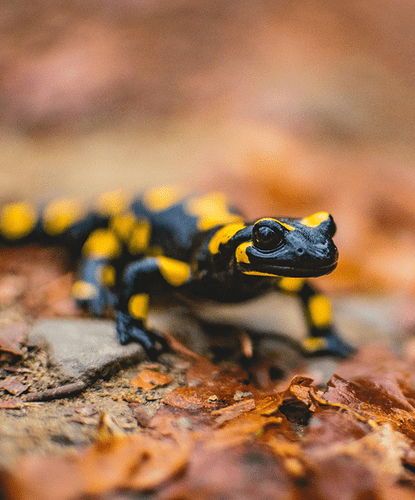
STAY IN THE KNOW
Sign up for our emails and get the latest animal health news straight to your inbox.

